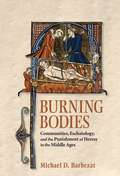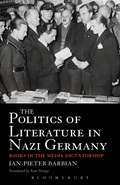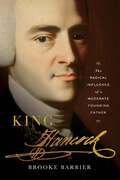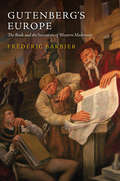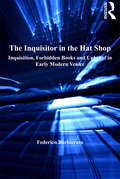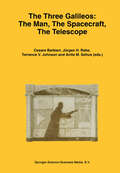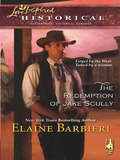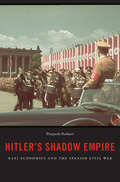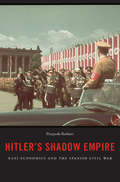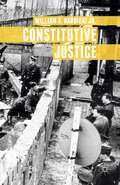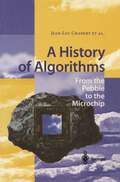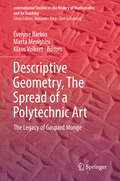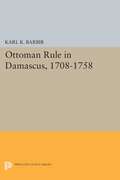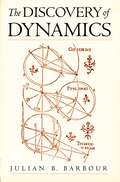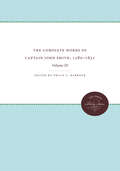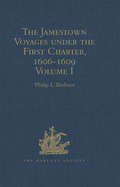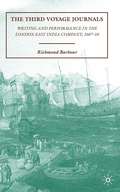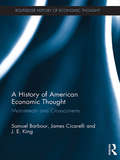- Table View
- List View
Burning Bodies: Communities, Eschatology, and the Punishment of Heresy in the Middle Ages
by Michael D. BarbezatBurning Bodies interrogates the ideas that the authors of historical and theological texts in the medieval West associated with the burning alive of Christian heretics. Michael Barbezat traces these instances from the eleventh century until the advent of the internal crusades of the thirteenth century, depicting the exclusionary fires of hell and judicial execution, the purifying fire of post-mortem purgation, and the unifying fire of God's love that medieval authors used to describe processes of social inclusion and exclusion.Burning Bodies analyses how the accounts of burning heretics alive referenced, affirmed, and elaborated upon wider discourses of community and eschatology. Descriptions of burning supposed heretics alive were profoundly related to ideas of a redemptive Christian community based upon a divine, unifying love, and medieval understandings of what these burnings could have meant to contemporaries cannot be fully appreciated outside of this discourse of communal love. For them, human communities were bodies on fire. Medieval theologians and academics often described the corporate identity of the Christian world as a body joined together by the love of God. This love was like a fire, melting individuals together into one whole. Those who did not spiritually burn with God's love were destined to burn literally in the fires of Hell or Purgatory, and the fires of execution were often described as an earthly extension of these fires. Through this analysis, Barbezat demonstrates how presentations of heresy, and to some extent actual responses to perceived heretics, were shaped by long-standing images of biblical commentary and exegesis. He finds that this imagery is more than a literary curiosity; it is, in fact, a formative historical agent.
The Politics of Literature in Nazi Germany: Books in the Media Dictatorship
by Jan-Pieter BarbianThis is the most comprehensive account to date of literary politics in Nazi Germany and of the institutions, organizations and people who controlled German literature during the Third Reich. Barbian details a media dictatorship-involving the persecution and control of writers, publishers and libraries, but also voluntary assimilation and pre-emptive self-censorship-that began almost immediately under the National Socialists, leading to authors' forced declarations of loyalty, literary propaganda, censorship, and book burnings. Special attention is given to Nazi regulation of the publishing industry and command over all forms of publication and dissemination, from the most presitigious publishing houses to the smallest municipal and school libraries. Barbian also shows that, although the Nazis censored books not in line with Party aims, many publishers and writers took advantage of loopholes in their system of control. Supporting his work with exhaustive research of original sources, Barbian describes a society in which everybody who was not openly opposed to it, participated in the system, whether as a writer, an editor, or even as an ordinary visitor to a library.
The Politics of Literature in Nazi Germany: Books in the Media Dictatorship
by Jan-Pieter BarbianThis is the most comprehensive account to date of literary politics in Nazi Germany and of the institutions, organizations and people who controlled German literature during the Third Reich. Barbian details a media dictatorship-involving the persecution and control of writers, publishers and libraries, but also voluntary assimilation and pre-emptive self-censorship-that began almost immediately under the National Socialists, leading to authors' forced declarations of loyalty, literary propaganda, censorship, and book burnings. Special attention is given to Nazi regulation of the publishing industry and command over all forms of publication and dissemination, from the most presitigious publishing houses to the smallest municipal and school libraries. Barbian also shows that, although the Nazis censored books not in line with Party aims, many publishers and writers took advantage of loopholes in their system of control. Supporting his work with exhaustive research of original sources, Barbian describes a society in which everybody who was not openly opposed to it, participated in the system, whether as a writer, an editor, or even as an ordinary visitor to a library.
King Hancock: The Radical Influence of a Moderate Founding Father
by Brooke BarbierA rollicking portrait of the paradoxical patriot, whose measured pragmatism helped make American independence a reality.Americans are surprisingly more familiar with his famous signature than with the man himself. In this spirited account of John Hancock’s life, Brooke Barbier depicts a patriot of fascinating contradictions—a child of enormous privilege who would nevertheless become a voice of the common folk; a pillar of society uncomfortable with radicalism who yet was crucial to independence. About two-fifths of the American population held neutral or ambivalent views about the Revolution, and Hancock spoke for them and to them, bringing them along.Orphaned young, Hancock was raised by his merchant uncle, whose business and vast wealth he inherited—including household slaves, whom Hancock later freed. By his early thirties, he was one of New England’s most prominent politicians, earning a place on Britain’s most-wanted list and the derisive nickname King Hancock. While he eventually joined the revolution against England, his ever moderate—and moderating—disposition would prove an asset after 1776. Barbier shows Hancock appealing to southerners and northerners, Federalists and Anti-Federalists. He was a famously steadying force as president of the fractious Second Continental Congress. He parlayed with French military officials, strengthening a key alliance with his hospitable diplomacy. As governor of Massachusetts, Hancock convinced its delegates to vote for the federal Constitution and calmed the fallout from the shocking Shays’s Rebellion.An insightful study of leadership in the revolutionary era, King Hancock traces a moment when passion was on the side of compromise and accommodation proved the basis of profound social and political change.
Gutenberg's Europe: The Book and the Invention of Western Modernity
by Frédéric BarbierMajor transformations in society are always accompanied by parallel transformations in systems of social communication – what we call the media. In this book, historian Frédéric Barbier provides an important new economic, political and social analysis of the first great 'media revolution' in the West: Gutenberg's invention of the printing press in the mid fifteenth century. In great detail and with a wealth of historical evidence, Barbier charts the developments in manuscript culture in the twelfth and thirteenth centuries, and shows how the steadily increasing need for written documents initiated the processes of change which culminated with Gutenberg. The fifteenth century is presented as the 'age of start-ups' when investment and research into technologies that were new at the time, including the printing press, flourished. Tracing the developments through the sixteenth century, Barbier analyses the principal features of this first media revolution: the growth of technology, the organization of the modern literary sector, the development of surveillance and censorship and the invention of the process of 'mediatization'. He offers a rich variety of examples from cities all over Europe, as well as looking at the evolution of print media in China and Korea. This insightful re-interpretation of the Gutenberg revolution also looks beyond the specific historical context to draw connections between the advent of print in the Rhine Valley ('paper valley') and our own modern digital revolution. It will be of great interest to students and scholars of early modern history, of literature and the media, and will appeal to anyone interested in what remains one of the greatest cultural revolutions of all time.
Gutenberg's Europe: The Book and the Invention of Western Modernity
by Frédéric BarbierMajor transformations in society are always accompanied by parallel transformations in systems of social communication – what we call the media. In this book, historian Frédéric Barbier provides an important new economic, political and social analysis of the first great 'media revolution' in the West: Gutenberg's invention of the printing press in the mid fifteenth century. In great detail and with a wealth of historical evidence, Barbier charts the developments in manuscript culture in the twelfth and thirteenth centuries, and shows how the steadily increasing need for written documents initiated the processes of change which culminated with Gutenberg. The fifteenth century is presented as the 'age of start-ups' when investment and research into technologies that were new at the time, including the printing press, flourished. Tracing the developments through the sixteenth century, Barbier analyses the principal features of this first media revolution: the growth of technology, the organization of the modern literary sector, the development of surveillance and censorship and the invention of the process of 'mediatization'. He offers a rich variety of examples from cities all over Europe, as well as looking at the evolution of print media in China and Korea. This insightful re-interpretation of the Gutenberg revolution also looks beyond the specific historical context to draw connections between the advent of print in the Rhine Valley ('paper valley') and our own modern digital revolution. It will be of great interest to students and scholars of early modern history, of literature and the media, and will appeal to anyone interested in what remains one of the greatest cultural revolutions of all time.
D-Day Deception: Operation Fortitude and the Normandy Invasion (Praeger Security International)
by Mary K. BarbierOn 6 June 1944, Allied forces stormed the beaches at Normandy. The invasion followed several years of argument and planning by Allied leaders, who remained committed to a return to the European continent after the Germans had forced the Allies to evacuate at Dunkirk in May 1940. Before the spring of 1944, however, Prime Minister Winston Churchill and other British leaders remained unconvinced that the invasion was feasible. At the Teheran Conference in November 1943, Franklin D. Roosevelt and Winston Churchill promised Josef Stalin that Allied troops would launch Operation Overlord, the invasion of Normandy, in the spring. Because of their continuing concerns about Overlord, the British convinced the Americans to implement a cover plan to help ensure the invasion's success. The London Controlling Section (LCS) devised an elaborate two-part plan called Operation Fortitude that SHAEF (Supreme Headquarters, Allied Expeditionary Force) helped to fine tune and that both British and American forces implementedHistorians analyzing the Normandy invasion frequently devote some discussion to Operation Fortitude. Although they admit that Fortitude North did not accomplish all that the Allied deception planners had hoped, many historians heap praise on Fortitude South, using phrases such as, unquestionably the greatest deception in military history. Many of these historians assume that the deception plan played a crucial role in the June 1944 assault. A reexamination of the sources suggests, however, that other factors contributed as much, if not more, to the Allied victory in Normandy and that Allied forces could have succeeded without the elaborate deception created by the LCS. Moreover, the persistent tendency to exaggerate the operational effect of Fortitude on the German military performance at Normandy continues to draw attention away from other, technical-military reasons for the German failures there.
The Inquisitor in the Hat Shop: Inquisition, Forbidden Books and Unbelief in Early Modern Venice
by Federico BarbieratoEarly modern Venice was an exceptional city. Located at the intersection of trade routes and cultural borders, it teemed with visitors, traders, refugees and intellectuals. It is perhaps unsurprising, then, that such a city should foster groups and individuals of unorthodox beliefs, whose views and life styles would bring them into conflict with the secular and religious authorities. Drawing on a vast store of primary sources - particularly those of the Inquisition - this book recreates the social fabric of Venice between 1640 and 1740. It brings back to life a wealth of minor figures who inhabited the city, and fostered ideas of dissent, unbelief and atheism in the teeth of the Counter-Reformation. The book vividly paints a scene filled with craftsmen, friars and priests, booksellers, apothecaries and barbers, bustling about the city spaces of sociability, between coffee-houses and workshops, apothecaries' and barbers' shops, from the pulpit and drawing rooms, or simply publicly speaking about their ideas. To give depth to the cases identified, the author overlays a number of contextual themes, such as the survival of Protestant (or crypto-Protestant) doctrines, the political situation at any given time, and the networks of dissenting groups that flourished within the city, such as the 'free metaphysicists' who gathered in the premises of the hatter Bortolo Zorzi. In so doing this rich and thought provoking book provides a systematic overview of how Venetian ecclesiastical institutions dealt with the sheer diffusion of heterodox and atheistical ideas at different social levels. It will be of interest not only to scholars of Venice, but all those with an interest in the intellectual, cultural and religious history of early-modern Europe.
The Inquisitor in the Hat Shop: Inquisition, Forbidden Books and Unbelief in Early Modern Venice
by Federico BarbieratoEarly modern Venice was an exceptional city. Located at the intersection of trade routes and cultural borders, it teemed with visitors, traders, refugees and intellectuals. It is perhaps unsurprising, then, that such a city should foster groups and individuals of unorthodox beliefs, whose views and life styles would bring them into conflict with the secular and religious authorities. Drawing on a vast store of primary sources - particularly those of the Inquisition - this book recreates the social fabric of Venice between 1640 and 1740. It brings back to life a wealth of minor figures who inhabited the city, and fostered ideas of dissent, unbelief and atheism in the teeth of the Counter-Reformation. The book vividly paints a scene filled with craftsmen, friars and priests, booksellers, apothecaries and barbers, bustling about the city spaces of sociability, between coffee-houses and workshops, apothecaries' and barbers' shops, from the pulpit and drawing rooms, or simply publicly speaking about their ideas. To give depth to the cases identified, the author overlays a number of contextual themes, such as the survival of Protestant (or crypto-Protestant) doctrines, the political situation at any given time, and the networks of dissenting groups that flourished within the city, such as the 'free metaphysicists' who gathered in the premises of the hatter Bortolo Zorzi. In so doing this rich and thought provoking book provides a systematic overview of how Venetian ecclesiastical institutions dealt with the sheer diffusion of heterodox and atheistical ideas at different social levels. It will be of interest not only to scholars of Venice, but all those with an interest in the intellectual, cultural and religious history of early-modern Europe.
The Three Galileos: The Man, The Spacecraft, The Telescope (Astrophysics and Space Science Library #220)
by Cesare Barbieri Jürgen H. Rahe Torrence V. Johnson Anita M. SohusThe idea of having a conference in Padova describing the results obtained by the Galileo spacecraft and the characteristics of the Telescopio Nazionale Galileo began in 1995, when a number of colleagues from both sides of the Atlantic began exchanging suggestions and ideas. Looking at the schedules of the two teams, it was clear that the beginning of January 1997 would be a good time to hold the conference; these dates also luckily coincided with the dates of the memorable discovery of the Medicean moons of Jupiter by Galileo Galilei in Padova in 1610. To emphasize these three elements, the name of the conference was then proposed and accepted by the involved parties: NASA and JPL in the United States, the German space agency DARA, the University of Padova, and the Astronomical Observatory in Padova. I wish to recall a few key dates: In January 1610, Galileo--from his house in Padova--had the first hint of three and then four stars connected to Jupiter. In December 1995, the probe released from the spacecraft entered the atmosphere of Jupiter, and the spacecraft entered orbit about Jupiter. These extraordinary events were followed at JPL by a number of representatives of many institutions and space agencies. In June 1996, the Telescopio Nazionale Galileo was inaugurated by the King of Spain Juan Carlos I, in the presence of Prof. Luigi Berlinguer, Minister of University and Science. These ceremonies occurred as the spacecraft started touring the moon Europa.
The Redemption Of Jake Scully: The Redemption Of Jake Scully Masked By Moonlight (Mills And Boon Historical Ser.)
by Elaine BarbieriIndulge your fantasies of delicious Regency Rakes, fierce Viking warriors and rugged Highlanders. Be swept away into a world of intense passion, lavish settings and romance that burns brightly through the centuries The loner the lady
Hitler's Shadow Empire: The Nazis And The Spanish Civil War
by Pierpaolo BarbieriThe Nazis provided Franco’s Nationalists with planes, armaments, and tanks in their civil war against the Communists but behind this largesse was a Faustian bargain. Pierpaolo Barbieri makes a convincing case that the Nazis hoped to establish an economic empire in Europe, and in Spain they tested the tactics intended for future subject territories.
Hitler's Shadow Empire: The Nazis And The Spanish Civil War
by Pierpaolo BarbieriThe Nazis provided Franco’s Nationalists with planes, armaments, and tanks in their civil war against the Communists but behind this largesse was a Faustian bargain. Pierpaolo Barbieri makes a convincing case that the Nazis hoped to establish an economic empire in Europe, and in Spain they tested the tactics intended for future subject territories.
Constitutive Justice
by William A. BarbieriBoth classical and modern accounts of justice largely overlook the question of how the communities within which justice applies are constituted in the first place. This book addresses that problem, arguing that we need to accord a place to the theory of 'constitutive justice' alongside traditional categories of distributive and commutative justice.
A History of Algorithms: From the Pebble to the Microchip
by E. Barbin J. Borowczyk J. L. Chabert M. Guillemot A. Michel-Pajus A. Djebbar J. C. MartzloffThe development of computing has reawakened interest in algorithms. Often neglected by historians and modern scientists, algorithmic procedures have been instrumental in the development of fundamental ideas: practice led to theory just as much as the other way round. The purpose of this book is to offer a historical background to contemporary algorithmic practice.
Descriptive Geometry, The Spread of a Polytechnic Art: The Legacy of Gaspard Monge (International Studies in the History of Mathematics and its Teaching)
by Évelyne Barbin Marta Menghini Klaus VolkertThis book seeks to explore the history of descriptive geometry in relation to its circulation in the 19th century, which had been favoured by the transfers of the model of the École Polytechnique to other countries. The book also covers the diffusion of its teaching from higher instruction to technical and secondary teaching. In relation to that, there is analysis of the role of the institution – similar but definitely not identical in the different countries – in the field under consideration. The book contains chapters focused on different countries, areas, and institutions, written by specialists of the history of the field. Insights on descriptive geometry are provided in the context of the mathematical aspect, the aspect of teaching in particular to non-mathematicians, and the institutions themselves.
Ottoman Rule in Damascus, 1708-1758
by Karl K. BarbirOn the basis of new evidence from the Ottoman archives in Istanbul, Karl Barbir challenges the current interpretation of Ottoman rule in Damascus during the eighteenth century. He argues that the prevailing themes of decline and stagnation--usually applied to the entire century--in fact apply only to the latter half of the century. This discovery, he contends, affords a more balanced and realistic view of the Near East's Ottoman past than previous studies have suggested.Originally published in 1980.The Princeton Legacy Library uses the latest print-on-demand technology to again make available previously out-of-print books from the distinguished backlist of Princeton University Press. These editions preserve the original texts of these important books while presenting them in durable paperback and hardcover editions. The goal of the Princeton Legacy Library is to vastly increase access to the rich scholarly heritage found in the thousands of books published by Princeton University Press since its founding in 1905.
The Discovery of Dynamics: A Study from a Machian Point of View of the Discovery and the Structure of Dynamical Theories
by Julian B. BarbourEver since Newton created dynamics, there has been controversy about its foundations. Are space and time absolute? Do they form a rigid but invisible framework and container of the universe? Or are space, time, and motion relative? If so, does Newton's 'framework' arise through the influence of the universe at large, as Ernst Mach suggested? Einstein's aim when creating his general theory of relativity was to demonstrate this and thereby implement 'Mach's Principle'. However, it is widely believed that he achieved only partial success. This question of whether motion is absolute or relative has been a central issues in philosophy; the nature of time has perennial interest. Current attempts to create a quantum description of the whole universe keep these issues at the cutting edge of modern research. Written by the world's leading expert on Mach's Principle, The Discovery of Dynamics is a highly original account of the development of notions about space, time, and motion. Widely praised in its hardback version, it is one of the fullest and most readable accounts of the astronomical studies that culminated in Kepler's laws of planetary motion and of the creation of dynamics by Galileo, Descartes, Huygens, and Newton. Originally published as Absolute or Relative Motion?, Vol. 1: The Discovery of Dynamics (Cambridge), The Discovery of Dynamics provides the technical background to Barbour's recently published The End of Time, in which he argues that time disappears from the description of the quantum universe.
The Complete Works of Captain John Smith, 1580-1631, Volume I: Volume I (Published by the Omohundro Institute of Early American History and Culture and the University of North Carolina Press #1)
by Philip L. BarbourEdited by the late Philip L. Barbour, acknowledged as the leading authority on Captain John Smith, this annotated three-volume work is the only modern edition of the works of the legendary figure who captured the interest of scholars and general readers for over four centuries. A hero and adventurer, Smith was the leader who saved Jamestown from self-destruction, and he was also instrumental in the exploration and settlement of New England. He produced one of the basic ethnological studies of the tide-water Algonkians, an invaluable contemporary history of early Virginia, the earliest well-defined maps of Chesapeake Bay and the New England coast, and the first printed dictionary of English nautical terms. This is Volume I of three volumes.Originally published in 2011.A UNC Press Enduring Edition -- UNC Press Enduring Editions use the latest in digital technology to make available again books from our distinguished backlist that were previously out of print. These editions are published unaltered from the original, and are presented in affordable paperback formats, bringing readers both historical and cultural value.
The Complete Works of Captain John Smith, 1580-1631, Volume II: Volume II (Published by the Omohundro Institute of Early American History and Culture and the University of North Carolina Press #2)
by Philip L. BarbourEdited by the late Philip L. Barbour, acknowledged as the leading authority on Captain John Smith, this annotated three-volume work is the only modern edition of the works of the legendary figure who captured the interest of scholars and general readers for over four centuries. A hero and adventurer, Smith was the leader who saved Jamestown from self-destruction, and he was also instrumental in the exploration and settlement of New England. He produced one of the basic ethnological studies of the tide-water Algonkians, an invaluable contemporary history of early Virginia, the earliest well-defined maps of Chesapeake Bay and the New England coast, and the first printed dictionary of English nautical terms. This is Volume II of three volumes.Originally published in 2011.A UNC Press Enduring Edition -- UNC Press Enduring Editions use the latest in digital technology to make available again books from our distinguished backlist that were previously out of print. These editions are published unaltered from the original, and are presented in affordable paperback formats, bringing readers both historical and cultural value.
The Complete Works of Captain John Smith, 1580-1631, Volume III: Volume III (Published by the Omohundro Institute of Early American History and Culture and the University of North Carolina Press #3)
by Philip L. BarbourEdited by the late Philip L. Barbour, acknowledged as the leading authority on Captain John Smith, this annotated three-volume work is the only modern edition of the works of the legendary figure who captured the interest of scholars and general readers for over four centuries. A hero and adventurer, Smith was the leader who saved Jamestown from self-destruction, and he was also instrumental in the exploration and settlement of New England. He produced one of the basic ethnological studies of the tide-water Algonkians, an invaluable contemporary history of early Virginia, the earliest well-defined maps of Chesapeake Bay and the New England coast, and the first printed dictionary of English nautical terms. This is Volume III of three volumes.Originally published in 2011.A UNC Press Enduring Edition -- UNC Press Enduring Editions use the latest in digital technology to make available again books from our distinguished backlist that were previously out of print. These editions are published unaltered from the original, and are presented in affordable paperback formats, bringing readers both historical and cultural value.
The Jamestown Voyages under the First Charter, 1606-1609: Documents relating to the Foundation of Jamestown and the History of the Jamestown Colony up to the Departure of Captain John Smith, last President of the Council in Virginia under the First Charter, early in October, 1609 (Hakluyt Society, Second Series)
by Philip L. BarbourIn December 1606, 120 emigrants left London in three small vessels. They landed nearly five months later in Virginia and founded a settlement which they called Jamestown. Thus the first permanent English colony was established in America. During the first few years, the colony was beset by extreme hardship. The local Indians regarded the settlement as infringement of their territory and were hostile to the settlers. Famine, plague and internal dissension also took their toll. The settlers relied for survival on provisions and men brought from England. The ships travelled the long route by way of the Canaries and the Caribbean and were always in danger of attack by the Spanish. In these 2 volumes Mr Barbour has collected all the known documents relating to the Jamestown voyages during the life of the original charter. He has annotated them and translated those written in languages other than English. In his introduction he reviews the early sources, in particular books about the early history of the colony written by emigrants. This collection gives a graphic and fascinating contemporary picture of the first few years of the colony out of which the United States was destined to grow. Includes a combined list of names of the original planters up to about 1 October 1608. The main pagination of this and the following volume (Second Series 137) is continuous. This is a new print-on-demand hardback edition of the volume first published in 1969.
The Jamestown Voyages under the First Charter, 1606-1609: Documents relating to the Foundation of Jamestown and the History of the Jamestown Colony up to the Departure of Captain John Smith, last President of the Council in Virginia under the First Charter, early in October, 1609 (Hakluyt Society, Second Series #137)
by Philip L. BarbourIn December 1606, 120 emigrants left London in three small vessels. They landed nearly five months later in Virginia and founded a settlement which they called Jamestown. Thus the first permanent English colony was established in America. During the first few years, the colony was beset by extreme hardship. The local Indians regarded the settlement as infringement of their territory and were hostile to the settlers. Famine, plague and internal dissension also took their toll. The settlers relied for survival on provisions and men brought from England. The ships travelled the long route by way of the Canaries and the Caribbean and were always in danger of attack by the Spanish. In these 2 volumes Mr Barbour has collected all the known documents relating to the Jamestown voyages during the life of the original charter. He has annotated them and translated those written in languages other than English. In his introduction he reviews the early sources, in particular books about the early history of the colony written by emigrants. This collection gives a graphic and fascinating contemporary picture of the first few years of the colony out of which the United States was destined to grow. Includes a combined list of names of the original planters up to about 1 October 1608. The main pagination of this and the following volume (Second Series 137) is continuous. This is a new print-on-demand hardback edition of the volume first published in 1969.
The Third Voyage Journals: Writing and Performance in the London East India Company, 1607-10
by R. BarbourThis volume publishes for the first time the collected journals of the East India Company's Third Voyage (1607-10), England's first to reach India, which proved pivotal to England's emergence as a global player.
A History of American Economic Thought: Mainstream and Crosscurrents (The Routledge History of Economic Thought)
by Samuel Barbour James Cicarelli J. E. KingThis vital addition to the Routledge History of Economic Thought series surveys arguably the most important country in the development of economics as we know it today – the United States of America. A History of American Economic Thought is a comprehensive study of American economics as it has evolved over time, with several singularly unique features including: a thorough examination of the economics of American aboriginals prior to 1492; a detailed discussion of American economics as it has developed during the last fifty years; and a generous dose of non-mainstream American economics under the rubrics "Other Voices" and "Crosscurrents." It is far from being a native American community, and numerous social reformers and those with alternative points of view are given as much weight as the established figures who dominate the mainstream of the profession. Generous doses of American economic history are presented where appropriate to give context to the story of American economics as it proceeds through the ages, from seventeenth-century pre-independence into the twentieth-first century packed full of influential figures including John Bates Clark, Thorstein Veblen, Irving Fisher, Paul Samuelson, and John Kenneth Galbraith, to name but a few. This volume has something for everyone interested in the history of economic thought, the nexus of American economic thought and American economic history, the fusion of American economics and philosophy, and the history of science.
